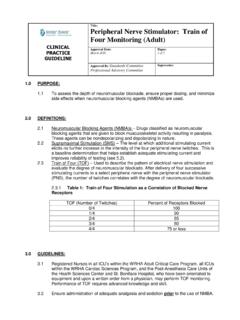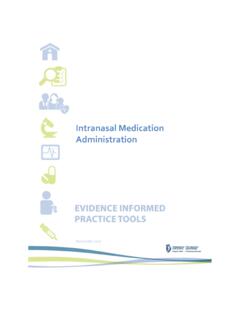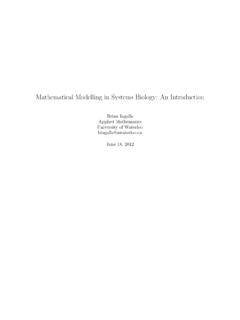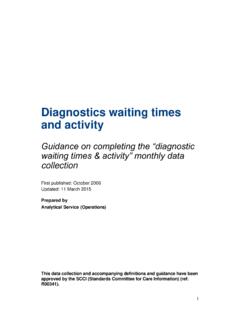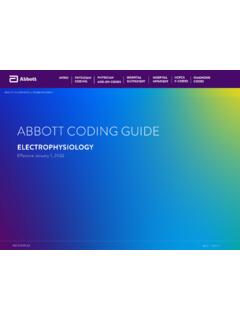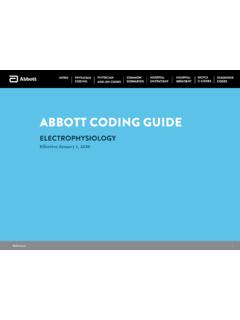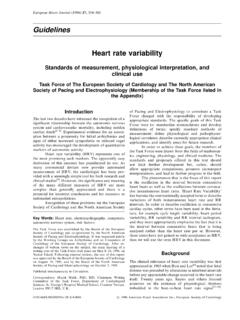Transcription of CLINICAL PRACTICE GUIDELINE - Telemetry
1 1 CLINICAL PRACTICE GUIDELINE - Telemetry introduction The purpose of the GUIDELINE is to establish evidence-informed criteria for Telemetry monitoring, outline nursing assessment parameters and provide patient education that may apply to adult patients located on cardiac or medical/surgical step down units within the Winnipeg Regional Health Authority (WRHA). The nursing assessment portion of the GUIDELINE is to facilitate appropriate communication and documentation of relevant information for selected adult patients requiring Telemetry .
2 These patients may be located on cardiac, medical/surgical inpatient units or Observation Units/Reassessment Units (where monitoring of patients may be provided by intensive care unit staff) within the WRHA. Actual patient care standards may vary depending on patient condition and accepted standards of PRACTICE for that condition. The GUIDELINE is a tool to facilitate decision-making regarding the appropriate use of Telemetry resources. The GUIDELINE is not intended to replace but to compliment individual CLINICAL decisions regarding patient care and management.
3 Working Group Members Name Organization Position Lorraine Avery WRHA Cardiac Sciences Co-lead Dr. Roger Philipp WRHA Cardiac Sciences Co-lead Anne Wolkenstein Seven Oaks General Hospital Member Cindy Ayotte/Karen Throndson Health Sciences Centre Member Christina Kuttnig St. Boniface General Hospital Member Karen Schnell-Hoehn St. Boniface General Hospital Member Susan Finlay Concordia General Hospital Member Rianna Arsenault Grace General Hospital Member Trudy Nernberg Grace General Hospital Member Myrna Stirling Victoria General Hospital Member Marianne Schillberg St.
4 Boniface General Hospital Member Frederica Emery Health Sciences Centre Member Cheryl Bilawka Health Sciences Centre Member Amanda Lucas Victoria General Hospital Member Rosemarie Syrota Seven Oaks General Hospital Member Mailah Damian Seven Oaks General Hospital Member Implementation date: October, 2012 2 TABLE OF CONTENTS GUIDELINE Assumptions 3 Definition: Telemetry 3 Guiding Principles 3 Criteria 4 Nursing Assessment 5 References 8 Appendix I.
5 Patient Education Material 9 3 GUIDELINE Assumptions The intent of the GUIDELINE is to identify appropriate criteria for the use of Telemetry . This GUIDELINE is not intended to establish appropriate criteria for patient care units where continuous cardiac monitoring is used routinely on admitted patients (example: intensive care unit). There are no known benchmarks for the required number of coronary care unit (CCU) or beds with Telemetry capabilities as a percentage of total cardiac beds except as a reflection of demand and level of service.
6 However, Telemetry capabilities should meet patient needs and provide the appropriate level of service. The decision to discontinue Telemetry is determined on an individual basis and is dependant upon individual CLINICAL situations and is therefore beyond the scope of the GUIDELINE . Definition Telemetry : A Telemetry unit records the electrical activity (ECG) of the heart. The Telemetry unit sends the data to a local monitoring system. The local monitoring system may be on the unit and/or located elsewhere (example coronary care or intensive care).
7 The purpose of Telemetry monitoring is to detect significant and life threatening variations in a patient s cardiac rhythm to facilitate early therapeutic intervention(s). Guiding Principles WRHA acute care facilities develop internal policies/procedures for Telemetry monitoring that adheres to the regional GUIDELINE . Designated physicians at each WRHA acute care facility approve requests for Telemetry within the designated Telemetry services. The need for Telemetry monitoring is assessed q24 hours by the requesting physician in consultation with the designated physician at each WRHA acute care facility.
8 WRHA acute care facilities develop internal policies for physician notification and response to Telemetry abnormalities. 4 CLINICAL PRACTICE GUIDELINE Telemetry Criteria Variable Standard/Frequency CCU Tertiary/ICU Community Inpatients units where Telemetry is available (Cardiology, Medical-surgical inpatient units) -Includes all cardiac/medical patients admitted to CCU/ICU who initially required continuous cardiac monitoring, are ready to mobilize, are appropriate for Telemetry monitoring and are ready for transfer to the ward.
9 -Includes patients who do not fulfill criteria for tertiary coronary care/community intensive care unit; 1. Decompensated heart failure 2. Moderate ST elevation AMI >24 48 hours 3. Asymptomatic bradycardia or tachycardia that the clinician believes requires further observation for a 24 48 hour period 4. Recent pre-syncope/syncope suspected to be related to cardiac arrhythmias 5. CLINICAL conditions that have pro-arrhythmic potential -Suspected pacemaker/implantable cardio-defibrillator (ICD) malfunction -Establishment of new anti-arrhythmic therapy 6.
10 Following cardiac procedures at the direction of the cardiologist -Elective percutaneous coronary intervention (PCI) complicated -Post ICD implant -Pacemaker implant without underlying rhythm (new lead placement) -Post electrophysiology (EP)/ablation Telemetry not required 1. Low risk acute coronary syndromes: -Normal or near-normal ECG with negative cardiac markers -Marginal troponin positive patients 2. Acute myocardial infarction beyond 48 hours where Telemetry monitoring is felt to be unnecessary 3.



